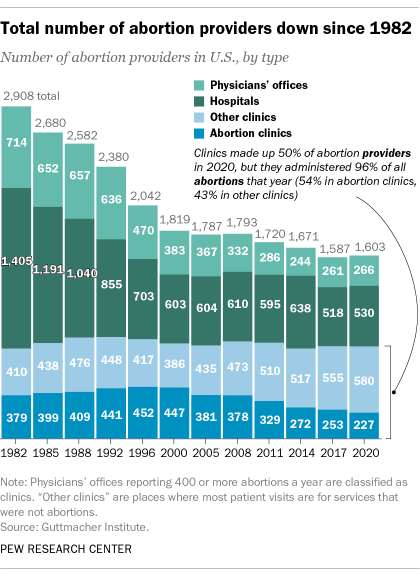Pew Research Center has conducted many surveys about abortion over the years, providing a lens into Americans’ views on whether the procedure should be legal, among a host of other questions. In a Center survey conducted after the Supreme Court’s June 2022 decision to end the constitutional right to abortion, 62% of U.S. adults said the practice should be legal in all or most cases, while 36% said it should be illegal in all or most cases. Another survey showed that relatively few Americans take an absolutist view on the issue.
Here is a look at data on the number of legal abortions that take place in the United States each year – and other related measures – from the Centers for Disease Control and Prevention (CDC) and the Guttmacher Institute, which have tracked these patterns for several decades. The latest data from both organizations is from 2020 and therefore does not reflect the period after the Supreme Court’s recent decision.
How many abortions are there in the U.S. each year?
An exact answer is hard to come by. The CDC and the Guttmacher Institute each try to measure this, but they use different methods and publish different figures.
The CDC compiles figures voluntarily reported by the central health agencies of the vast majority of states (including separate figures for New York City) and the District of Columbia. Its latest totals do not include figures from California, Maryland or New Hampshire, which did not report data to the CDC. (Read the methodology from the latest CDC report.)
The Guttmacher Institute compiles its figures after contacting every known provider of abortions – clinics, hospitals and physicians’ offices – in the country. It uses questionnaires and health department data, and provides estimates for abortion providers that don’t respond to its inquiries. Guttmacher’s figures are higher than the CDC’s in part because it includes data (and in some instances, estimates) from all 50 states. The institute’s latest full report, and its methodology, can be found here. While the Guttmacher Institute supports abortion rights, its empirical data on abortions in the U.S. has been widely cited by groups and publications across the political spectrum, including by a number of those that disagree with its positions.
The last year for which the CDC and Guttmacher reported a yearly national total for abortions is 2020, and neither organization reported a large change from the previous year. The CDC says there were 620,327 abortions nationally in 2020 in the District of Columbia and 47 states, a 1.5% decrease from 629,898 in 2019. Guttmacher’s national total for 2020 was 930,160, a 1.5% increase from 916,460 in 2019.
The figures reported by both organizations include only legal induced abortions conducted by clinics, hospitals or physicians’ offices, or those that make use of abortion pills dispensed from certified facilities such as clinics or physicians’ offices. They do not account for the use of abortion pills that were obtained outside of clinical settings.
How has the number of abortions in the U.S. changed over the years?

The annual number of U.S. abortions rose for years after Roe v. Wade legalized the procedure in 1973, reaching its highest levels around the late 1980s and early 1990s, according to both the CDC and Guttmacher. Since then, abortions have generally decreased at what a CDC analysis called “a slow yet steady pace.”
Guttmacher recorded more than 1.5 million abortions in the U.S. in 1991, about two-thirds more than the 930,160 it reported for 2020. The CDC reported just over 1 million abortions in 1991 and 620,327 in 2020, looking at just the District of Columbia and the 47 states that reported figures in both years. (This line graph shows the long-term trend in the number of legal abortions reported by both organizations. To allow for consistent comparisons over time, the CDC figures in the chart have been adjusted to ensure that the same states are counted from one year to the next. Using that approach, the CDC figure for 2020 is 615,911 legal abortions.)
There have been occasional breaks in this long-term pattern of decline – during the middle of the first decade of the 2000s, and then again in the late 2010s. The CDC reported modest 1% and 2% increases in abortions in 2018 and 2019, respectively, while Guttmacher reported an 8% increase in abortions over the three-year period from 2017 to 2020.
As noted above, these figures do not include abortions that use pills that were obtained outside of clinical settings.
What is the abortion rate among women in the U.S.? How has it changed over time?
Guttmacher says that in 2020 there were 14.4 abortions in the U.S. per 1,000 women ages 15 to 44. Its data shows that the rate of abortions among women has generally been declining in the U.S. since 1981, when it reported there were 29.3 abortions per 1,000 women in that age range.
The CDC says that in 2020, there were 11.2 abortions in the U.S. per 1,000 women ages 15 to 44. (That figure excludes data from California, Maryland, New Hampshire and the District of Columbia.) Like Guttmacher’s data, the CDC’s figures also suggest a general decline in the abortion rate over time. In 1980, when the CDC reported on all 50 states and D.C., it said there were 25 abortions per 1,000 women ages 15 to 44.
That said, both Guttmacher and the CDC say there were slight increases in the rate of abortions during the late 2010s. Guttmacher says the abortion rate per 1,000 women ages 15 to 44 rose from 13.5 in 2017 to 14.4 in 2020. The CDC says it rose from 11.2 in 2017 to 11.4 in 2019 before falling back to 11.2 in 2020. (The CDC’s figures for those years exclude data from California, Maryland, New Hampshire and the District of Columbia).
What are the most common types of abortion?
The CDC broadly divides abortions into two categories: surgical abortions and medication abortions, which involve pills. Since the Food and Drug Administration first approved abortion pills in 2000, their use has increased over time as a share of abortions nationally, according to both the CDC and Guttmacher. In fact, 2020 marked the first time that a majority of legal abortions in the U.S. involved pills: 53%, according to both the CDC and Guttmacher. That was up from 44% in 2019 and 40% in 2018, according to the CDC. (The CDC’s figures for 2020 include D.C. and 44 states that provided this data; its figures for 2019 figures included D.C. and 45 states, and its figures for 2018 included D.C. and 43 states.) Guttmacher, which measures this every three years, said that in 2017, 39% of U.S. abortions involved pills.
Two pills commonly used together for medication abortions are mifepristone, which, taken first, blocks hormones that support a pregnancy, and misoprostol, which then causes the uterus to empty. Medication abortions are safe to use until 10 weeks into pregnancy, according to the FDA.
Surgical abortions conducted during the first trimester of pregnancy typically use a suction process, while the relatively few surgical abortions that occur during the second trimester of a pregnancy typically use a process called dilation and evacuation, according to the UCLA School of Medicine website.
How many abortion providers are there in the U.S., and how has that number changed?
In 2020, there were 1,603 facilities in the U.S. that provided abortions, according to Guttmacher. This included 807 clinics, 530 hospitals and 266 physicians’ offices.

While clinics make up half of the facilities that provide abortions, they are the sites where the vast majority (96%) of abortions are administered, either through procedures or the distribution of pills, according to Guttmacher’s 2020 data. (This includes 54% of abortions that are administered at specialized abortion clinics and 43% at nonspecialized clinics.) Hospitals made up 33% of the facilities that provided abortions in 2020 but accounted for only 3% of abortions that year, while just 1% of abortions were conducted by physicians’ offices.
Looking just at clinics – that is, the total number of specialized abortion clinics and nonspecialized clinics in the U.S. – Guttmacher found the total virtually unchanged between 2017 (808 clinics) and 2020 (807 clinics). However, there were regional differences. In the Midwest, the number of clinics that provide abortions increased by 11% during those years, and in the West by 6%. The number of clinics decreased during those years by 9% in the Northeast and 3% in the South.
The total number of abortion providers has declined dramatically since the 1980s. In 1982, according to Guttmacher, there were 2,908 facilities providing abortions in the U.S., including 789 clinics, 1,405 hospitals and 714 physicians’ offices.
The CDC does not track the number of abortion providers.
What percentage of abortions are for women who live in a different state from the abortion provider?
In the District of Columbia, New York City and the 46 states that provided abortion and residency information to the CDC in 2020, 9.7% of all abortions were performed on women whose state of residence was known to be different than the state where the abortion occurred – virtually the same percentage as in 2019 (9.3%).
The share of reported abortions performed on women outside their state of residence was much higher before the 1973 Roe decision that stopped states from banning abortion. In 1972, 41% of all abortions in D.C. and the 20 states that provided this information to the CDC that year were performed on women outside their state of residence. In 1973, the corresponding figure was 21% in the District of Columbia and the 41 states that provided this information, and in 1974 it was 11% in D.C. and the 43 states that provided data.
In the months prior to the Supreme Court’s overturning of Roe v. Wade, politicians in some states with permissive abortion laws (such as New York, California and Oregon) introduced measures to assist women from states with restrictive abortion laws. Some examples included providing additional state funds for women’s travel expenses and for abortion clinics that were expecting more out-of-state patients.
What are the demographics of women who had abortions in 2020?
In the 46 states that reported data to the CDC in 2020, the majority of women who had abortions (57%) were in their 20s, while about three-in-ten (31%) were in their 30s. Teens ages 13 to 19 accounted for 8% of those who had abortions, while women in their 40s accounted for 4%.
The vast majority of women who had abortions in 2020 were unmarried (86%), while married women accounted for 14%, according to the CDC, which had data on this from 39 states and New York City (but not the rest of New York).
In the District of Columbia and 29 states that reported racial and ethnic data on abortion to the CDC, 39% of all women who had abortions in 2020 were non-Hispanic Black, while 33% were non-Hispanic White, 21% were Hispanic, and 7% were of other races or ethnicities.

Among those ages 15 to 44, there were 24.4 abortions per 1,000 non-Hispanic Black women; 11.4 abortions per 1,000 Hispanic women; 6.2 abortions per 1,000 non-Hispanic White women; and 12.7 abortions per 1,000 women of other races or ethnicities in that age range, the CDC reported from those same 29 states and the District of Columbia.
For 58% of U.S. women who had induced abortions in 2020, it was the first time they had ever had one, according to the CDC. For nearly a quarter (24%), it was their second abortion. For 10% of women, it was their third, and for 8% it was their fourth or higher. These CDC figures include data from 41 states and New York City (but not the rest of New York).
Nearly four-in-ten women who had abortions in 2020 (39%) had no previous live births at the time they had an abortion, according to the CDC. A quarter of women who had abortions in 2020 had one previous live birth, 20% had two previous live births, 10% had three, and 6% had four or more previous live births. These CDC figures include data from 42 states and New York City (but not the rest of New York).
When during pregnancy do most abortions occur?

The vast majority of abortions occur during the first trimester of a pregnancy. In 2020, 93% of abortions occurred during the first trimester – that is, at or before 13 weeks of gestation, according to the CDC. An additional 6% occurred between 14 and 20 weeks of pregnancy, and 1% were performed at 21 weeks or more of gestation. These CDC figures include data from 40 states and New York City (but not the rest of New York).
How often are there medical complications from abortion?
About 2% of all abortions in the U.S. involve some type of complication for the woman, according to an article in Statpearls, an online health care resource. The article says that “most complications are considered minor such as pain, bleeding, infection and post-anesthesia complications.”
The CDC calculates case-fatality rates for women from legal induced abortions – that is, how many women die from abortion-related complications, for every 100,000 abortions that occur in the U.S. The rate was lowest during the most recent period examined by the agency (2013 to 2019), when there were 0.43 deaths to women per 100,000 legal induced abortions. The case-fatality rate reported by the CDC was highest during the first period examined by the agency (1973 to 1977), when it was 2.1 deaths to women per 100,000 legal induced abortions. During the five-year periods in between, the figure ranged from 0.5 (from 1993 to 1997) to 0.8 (from 1978 to 1982). The CDC says it calculates death rates by five-year and seven-year periods because of year-to-year fluctuation in the numbers and due to the relatively low number of women who die from abortion.
In 2019, the last year for which the CDC has information, four women in the U.S. died due to complications from induced abortions, according to the CDC. Two women died in this way in 2018, and three women in 2017. (These deaths all followed legal abortions.) In 2016, the CDC reported seven deaths due to either legal (six) or illegal (one) induced abortions. Since 1990, the annual number of deaths among women due to induced abortion has ranged from two to 12, according to the CDC.
The annual number of reported deaths from induced abortions tended to be higher in the 1980s, when it ranged from nine to 16, and from 1972 to 1979, when it ranged from 13 to 54 (1972 was the first year the CDC began collecting this data). One driver of the decline was the drop in deaths from illegal abortions. There were 35 deaths from illegal abortions in 1972, the last full year before Roe v. Wade. The total fell to 19 in 1973 and to single digits or zero every year after that. (The number of deaths from legal abortions has also declined since then, though with some slight variation over time.)
The number of deaths from induced abortions was considerably higher in the 1960s than afterward. For instance, there were 235 deaths from abortions in 1965 and 280 in 1963, according to reports by the then-U.S. Department of Health, Education and Welfare, a precursor to the Department of Health and Human Services. The CDC is a division of Health and Human Services.
CORRECTION (Jan. 13, 2023): This post has been updated to reflect the correct attribution of data on the percentage of abortions in the U.S. that involve some type of medical complication for the woman. The correct source is Statpearls.






